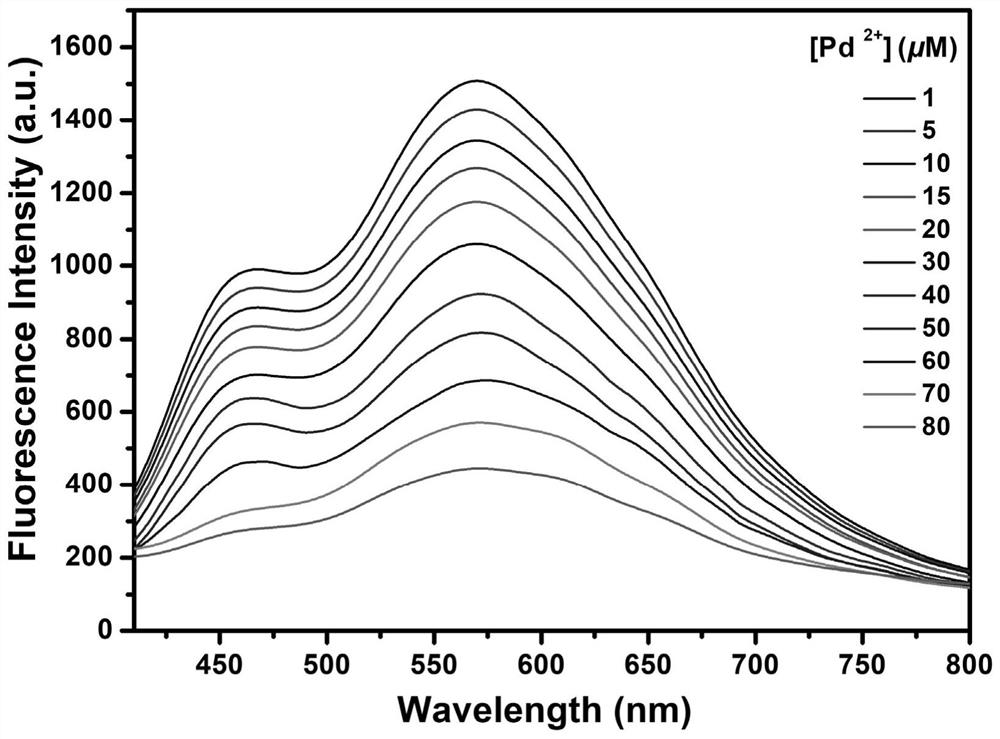Covalent organic framework fluorescent test paper for detecting palladium ions in water and preparation method thereof
A covalent organic framework, palladium ion technology, used in fluorescence/phosphorescence, chemical instruments and methods, luminescent materials, etc., to achieve wide application prospects, low detection limits, and fast analysis.
- Summary
- Abstract
- Description
- Claims
- Application Information
AI Technical Summary
Problems solved by technology
Method used
Image
Examples
Embodiment 1
[0044] A method for preparing a covalent organic framework fluorescent test paper for detecting palladium ions in water, comprising the following steps:
[0045] (1) Soak the blank filter paper in the dioxane solution and mesitylene mixed with 0.025mmol organic small molecule tritylaldehyde, 2,5-bis(allyloxy)terephthalic hydrazide In the ampoule bottle of solution 3mL; The dioxane solution of described 2,5-bis(allyloxyl) terephthalic hydrazide is 2,5-bis(allyloxyl) terephthalamide of 9mg Prepared by dissolving hydrazide in 0.8mL of dioxane;
[0046] (2) Add 0.1mL acetic acid to the bottle, and ultrasonically disperse the solvent for 10 minutes; the concentration of the acetic acid solution is 3M;
[0047] (3) After the refrigeration cycle pumps air three times, seal the ampoule bottle and react at 120°C for 3 days;
[0048] (4) After the filter paper is taken out, wash it with acetone for 3 times, place it in a clean and ventilated place, and let it dry naturally to obtain t...
Embodiment 2
[0050] A method for preparing a covalent organic framework fluorescent test paper for detecting palladium ions in water, comprising the following steps:
[0051] (1) Soak blank filter paper in dioxane solution and mesitylene mixed with 0.03mmol organic small molecule tritylaldehyde, 2,5-bis(allyloxy)terephthalic hydrazide In the ampoule bottle of solution 3.5mL; The dioxane solution of described 2,5-bis(allyloxyl) terephthalhydrazide is 10mg of 2,5-bis(allyloxyl) terephthalamide Prepared by dissolving formylhydrazide in 1mL of dioxane;
[0052] (2) Add 0.15mL acetic acid to the bottle, and ultrasonically disperse the solvent for 10 minutes; the concentration of the acetic acid solution is 4.5M;
[0053] (3) After the refrigeration cycle pumps air three times, seal the ampoule bottle and react at 120°C for 3 days;
[0054] (4) After the filter paper is taken out, wash it with acetone for 3 times, place it in a clean and ventilated place, and let it dry naturally to obtain the...
Embodiment 3
[0056] A method for preparing a covalent organic framework fluorescent test paper for detecting palladium ions in water, comprising the following steps:
[0057] (1) Soak blank filter paper in dioxane solution and mesitylene mixed with 0.038mmol organic small molecule tritylaldehyde, 2,5-bis(allyloxy)terephthalic hydrazide In the ampoule bottle of solution 4.5mL; The dioxane solution of described 2,5-bis(allyloxyl) terephthalhydrazide is 11.5mg of 2,5-bis(allyloxyl)p-phenylene Prepared by dissolving dimethylhydrazide in 1.5mL of dioxane;
[0058] (2) Add 0.2mL acetic acid to the bottle, and ultrasonically disperse the solvent for 10 minutes; the concentration of the acetic acid solution is 6M;
[0059] (3) After the refrigeration cycle pumps air three times, seal the ampoule bottle and react at 120°C for 3 days;
[0060] (4) After the filter paper is taken out, wash it with acetone for 3 times, place it in a clean and ventilated place, and let it dry naturally to obtain the ...
PUM
 Login to View More
Login to View More Abstract
Description
Claims
Application Information
 Login to View More
Login to View More - R&D
- Intellectual Property
- Life Sciences
- Materials
- Tech Scout
- Unparalleled Data Quality
- Higher Quality Content
- 60% Fewer Hallucinations
Browse by: Latest US Patents, China's latest patents, Technical Efficacy Thesaurus, Application Domain, Technology Topic, Popular Technical Reports.
© 2025 PatSnap. All rights reserved.Legal|Privacy policy|Modern Slavery Act Transparency Statement|Sitemap|About US| Contact US: help@patsnap.com



